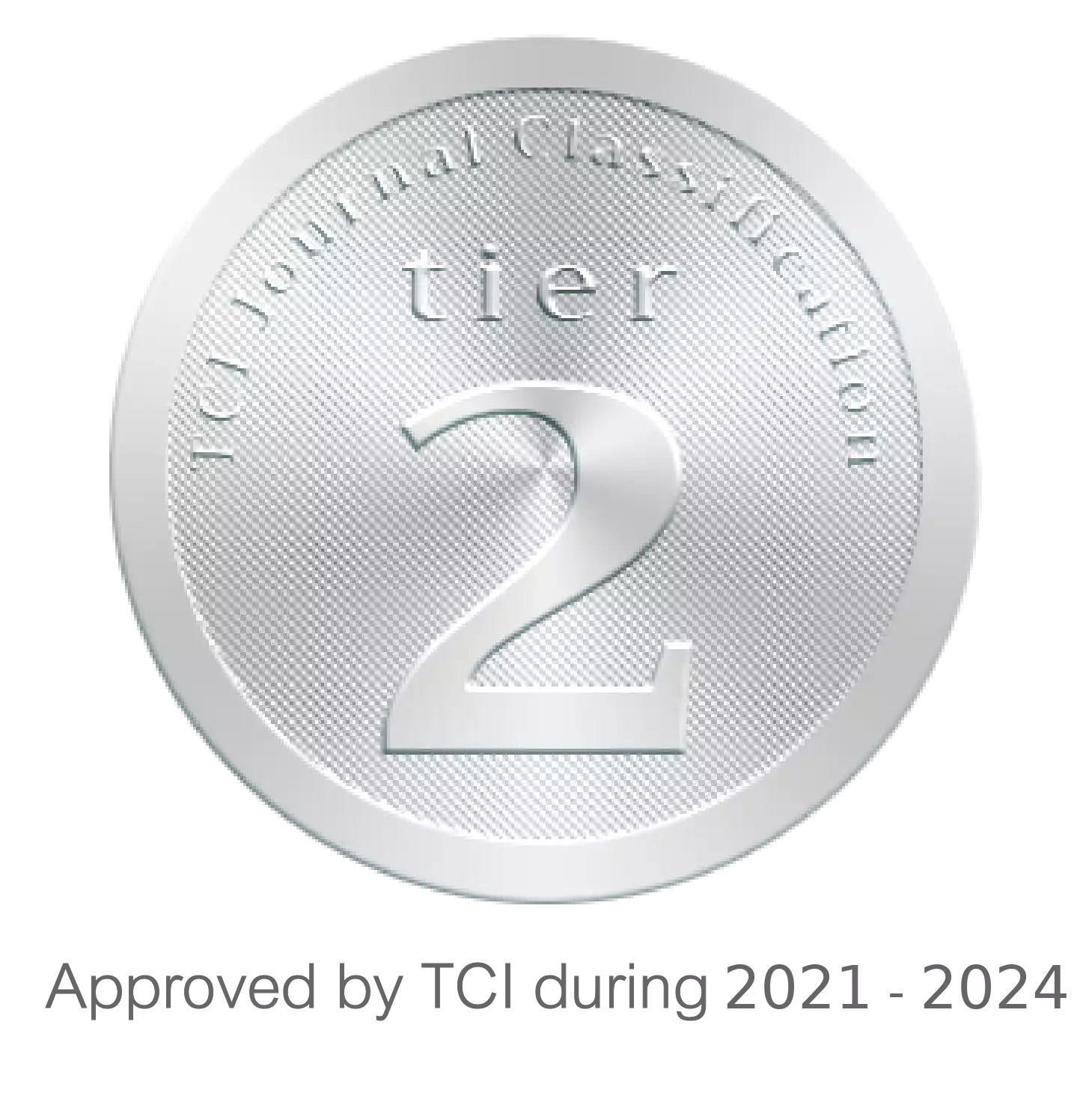การวิเคราะห์องค์ประกอบร่วมและความตั้งใจซื้อสินค้าข้าวเกษตรอินทรีย์แปรรูปอบกรอบของผู้บริโภค
คำสำคัญ:
การวิเคราะห์องค์ประกอบร่วม, ข้าวอบกรอบ , คุณลักษณะสินค้า, ความตั้งใจซื้อบทคัดย่อ
งานวิจัยนี้มีวัตถุประสงค์เพื่อศึกษาคุณลักษณะของข้าวเกษตรอินทรีย์แปรรูปอบกรอบโดยการใช้เทคนิคการวิเคราะห์องค์ประกอบร่วม และศึกษาความตั้งใจซื้อข้าวเกษตรอินทรีย์แปรรูปอบกรอบของผู้บริโภคเพื่อเป็นแนวทางในการพัฒนาคุณลักษณะผลิตภัณฑ์ข้าวเกษตรอินทรีย์แปรรูปอบกรอบให้เป็นที่ต้องการ สามารถดึงดูดใจ และสร้างความพึงพอใจแก่ผู้บริโภค งานวิจัยนี้เก็บข้อมูลโดยใช้แบบสอบถาม เก็บข้อมูลจากผู้บริโภคข้าวแปรรูปในประเทศไทย จำนวน 400 ราย ผลการวิเคราะห์คุณลักษณะโดยการวิเคราะห์องค์ประกอบร่วมพบว่า ความพึงพอใจที่มีต่อระดับคุณลักษณะของข้าวเกษตรอินทรีย์แปรรูปอบกรอบ ผู้บริโภคมีความพึงพอใจต่อคุณลักษณะด้านตราสินค้า และด้านรูปแบบดึงดูดมากที่สุด รองลงมาคือ ด้านท็อปปิ้งธัญพืช ด้านสโลแกนเพื่อสุภาพ ด้านความหวานปกติ และด้านบรรจุภัณฑ์รูปแบบถุงซิปล็อค และจากการทดสอบความแตกต่างพบว่า เพศชายและเพศหญิงมีความแตกต่างกันในเรื่องความตั้งใจซื้อสินค้าข้าวอบกรอบ ซึ่งเพศชายมีความเป็นไปได้ที่จะซื้อข้าวเกษตรอินทรีย์แปรรูปอบกรอบมากกว่าเพศหญิง โดยมีระดับนัยสำคัญทางสถิติที่ระดับ 0.05 ผลการวิจัยสามารถเป็นแนวทางในการวางแผนกลยุทธ์ทางการตลาดให้มีประสิทธิภาพสูงสุดและพัฒนาคุณลักษณะผลิตภัณฑ์ข้าวเกษตรอินทรีย์แปรรูปอบกรอบให้โดดเด่นเป็นที่ต้องการของผู้บริโภค เพิ่มความสามารถในการแข่งขันของผู้ประกอบการได้มากขึ้น
##plugins.generic.usageStats.downloads##
เอกสารอ้างอิง
กรมการค้าต่างประเทศ. (2564). ส่งออกข้าวไทยปี 64 พร้อมกางแผนส่งเสริมตลาดข้าวไทยสู้วิกฤต COVID. สืบค้นเมื่อ 2 ตุลาคม 2656, จาก https://www.dft.go.th/thth/NewsList/News-
ชุดา วรวัฒนธรรม และ เปรมฤดี จิตรเกื้อกูล. (2564). การวิเคราะห์องค์ประกอบร่วมของคุณลักษณะข้าวสารบรรจุถุงปัจจัยกำหนดราคาและอิทธิพลของการส่งเสริมการตลาดต่อคุณค่าตราสินค้าข้าวสารบรรจุถุง กรณีศึกษา จังหวัดนครพนม. วารสารศิลปศาสตร์และวิทยาการจัดการ มหาวิทยาลัยเกษตรศาสตร์, 9(1), 31-49
ฐานเศรษฐกิจ. (2563). ส่งออกข้าวปี 62 ต่ำสุดรอบ 6 ปี. สืบค้นเมื่อ 21 ตุลาคม 2656, จาก https://www.thansettakij.com/business/421299
นิภาพร กุลณา, สุรีย์ ทองกร, พิมพ์ณดา นนประสาท และปนัดดา พึ่งศิลป์. (2564). การพัฒนาผลิตภัณฑ์ธัญพืชอัดแท่งที่มีใยอาหารสูงจากข้าวกล้องสินเหล็ก. วารสารวิทยาลัยดุสิตธานี, 15(1), มกราคม-เมษายน 2564.
ภาคภูมิ พิชญ์หาญณรงค์ และ อภิชาต ดะลุณเพธย์. (2559). ความพึงพอใจของเกษตรกรที่มีต่อเงื่อนไขในสัญญาการขายสับปะรดโรงงานในจังหวัดระยอง. วารสารเศรษฐศาสตร์และนโยบายสาธารณะ, 7(13), 1-19.
ศุภัสรัตน์ อินพิลา. (2558). ปัจจัยที่มีผลต่อการตัดสินใจเลือกซื้อข้าวหอมมะลิอินทรีย์: การวิเคราะห์องค์ประกอบร่วม (วิทยานิพนธ์วิทยาศาสตร์มหาบัณฑิตสาขาธุรกิจการเกษตร, มหาวิทยาลัยเกษตรศาสตร์).
สมาคมผู้ส่งออกข้าวไทย. (2565). ประวัติศาสตร์ข้าวโลก. สืบค้นเมื่อ 21 ตุลาคม 2656, จาก http://www.thai rice exporters.or.th/rice_profile.htm
สำนักงานพัฒนาการวิจัยเกษตร. (2563). พืชเศรษฐกิจ สินค้าสร้างรายได้ในครัวเรือนและประเทศ. สืบค้นเมื่อ 21 ตุลาคม 2656, จาก https://www.arda.or.th/knowledge_list.php?page=3
สิริรัญญา อุบาลี, วิศิษฐ์ ลิ้มสมบุญชัย และอภิชาต ดะลุณเพธย์. (2561). ความพึงพอใจและความเต็มใจจ่ายของผู้บริโภคต่อคุณลักษณะของนมพร้อมดื่มอินทรีย์ในเขตกรุงเทพมหานคร. วารสารมหาวิทยาลัยราชภัฏร้อยเอ็ด, 12, 43-49.
Ajzen, I, & Fishbein, M. (1980). Understanding attitudes and predicting social behavior. Englewood Cliffs, NJ: Prentice-Hall.
Ajzen, I. (1991). The theory of planned behavior Organizational Behavior and Human Decision Processes, 50, 179-211.
Blackwell, R. D., Miniard, P. W., & Engel, J. F. (2001). Consumer behavior (9th ed.). Orlando: Harcourt.
Brand Buffet. (2563). ซันไบทส์ “ผสมผักรวม รสน้ำสลัดญี่ปุ่น” เอาใจคนรักสุขภาพ. สืบค้นเมื่อ 21 ตุลาคม 2656, จาก https://www.brandbuffet.in.th/2012/09/sunbite-japanese-dressing-salad/
Demirtas, E. A., Anagun, A. S., & Koksal, G. (2009). Determination of optimal product styles by ordinal logistic regression versus conjoint analysis for kitchen faucets. International Journal of Industrial Ergonomics, 39(5), 866-875.
DeSarbo, W. S., & DeSarbo, C. F. (2001). A generalized normative segmentation methodology employing conjoint analysis (pp. 447-478). Springer Berlin Heidelberg.
Fagerstrøm, A., Eriksson, N., Khamtanet, S., Jitkuekul, P., Sigurdsson, V., & Larsen, N. M. (2022). The relative impact of health communication conveyed via quick response codes: A conjoint experiment among young thai consumers doing grocery shopping. Health Marketing Quarterly, 1-20.
Fillgoods. (2563). สร้างธุรกิจด้วยแผนการตลาดหลัก 4P สร้างยอดขายให้ทะลุเป้า. สืบค้นเมื่อ 21 ตุลาคม 2656, จาก
https://www.fillgoods.co/online-biz/shop-orders-build-business-with-4p-make-more-sale/
Kothandapani, V. (1971). A phychological approach to the prediction of contraception behavior. North Carolina: Popilation Center.
Krejcie, R. V., & Morgan, D. W. (1970). Determining sample size for research activities. Educational and Psychological Measurement, 30(3), 607-610
Lancaster, K. J. (1971). Consumer Demand: A New Approach. New York: Columbia University.
Likert, R. (1967). The Method of Constructing and Attitude Scale. In Reading in Fishbeic, M (Ed.), Attitude Theory and Measurement (pp. 90-95). New York: Wiley & Son.
Moutaftsi, P., & Kyratsis, P. (2016). Visual brand identity of food products: a customer’s perspective. Journal of Applied Packaging Research, 8(3), 1-14.
Priem, R. L. (1992). An application of metric conjoint analysis for the evaluation of top managers' individual strategic decision-making processes: a research note. Strategic management journal, 13(S1), 143-151.









